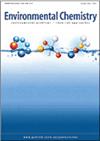碳纳米管负载和环境应力对环氧树脂和聚碳酸酯纳米复合材料中聚合物相关化学物质浸出的影响
IF 2.3
4区 环境科学与生态学
Q3 CHEMISTRY, ANALYTICAL
引用次数: 4
摘要
纳米颗粒(如碳纳米管)被越来越多地添加到聚合物基体中,以提高抗拉强度、导电性和导热性,并降低气体渗透性。在使用过程中和处理后,这些塑料纳米复合材料(pnc)通过物理和化学过程,包括机械磨损、紫外线照射、水解和氧化,降解成微塑料。这类聚合物有可能进入水生环境,释放出与聚合物相关的潜在危险化学品和转化产物。本研究确定并量化了在模拟环境暴露过程中从聚合物和纳米复合材料中浸出的聚合物相关化学物质。含单壁碳纳米管(SWCNT)的环氧树脂和聚碳酸酯pnc在水中暴露5天,测量化学物质双酚A (BPA)和4-叔丁基酚(TBP)的释放量。研究了紫外光照射、pH、温度和天然有机质对化学物质释放的调节作用。温度、pH和紫外光是影响pnc中TBP和BPA释放的最显著因素。此外,在聚碳酸酯和环氧复合材料中增加碳纳米管负载可以减少这些酚类化学物质的释放。当swcnts负载增加0.3%时,BPA的释放量减少45.18%,当swcnts负载增加1%时,BPA和TBP的化学释放量分别减少48.26%和58.8%。这些信息提供了重要的数据,可用于帮助评估水环境中swcnts聚合物纳米复合材料带来的风险,特别是当它们老化和转化时。本文章由计算机程序翻译,如有差异,请以英文原文为准。
Influence of CNT loading and environmental stressors on leaching of polymer-associated chemicals from epoxy and polycarbonate nanocomposites
Nanoparticles such as carbon nanotubes are increasingly added to polymer matrices to improve tensile strength and electrical and thermal conductivity, and to reduce gas permeability. During use and after disposal, these plastic nanocomposites (PNCs) are degraded into microplastics by physical and chemical processes including mechanical abrasion, UV light exposure, hydrolysis and oxidation. Such polymers have the potential to enter aquatic environments and release potentially hazardous polymer-associated chemicals and transformation products. This work identifies and quantifies polymer-associated chemicals leached from polymers and nanocomposites during simulated environmental exposure. Epoxy and polycarbonate PNCs containing single-walled carbon nanotube (SWCNT) loadings ranging from 0 to 1 wt-% were exposed to water for 5 days, and the release of the chemicals bisphenol A (BPA) and 4-tert-butylphenol (TBP) was measured. The role of UV exposure, pH, temperature and natural organic matter in regulating chemical release was also investigated. Temperature, pH and UV light were found to be the most significant factors influencing release of TBP and BPA from PNCs. Additionally, increasing carbon nanotube loading in both polycarbonate and epoxy composites was found to decrease the release of these phenolic chemicals. A 0.3% higher SWCNT loading decreased the release of BPA 45 18%, and a 1 % SWCNT loading decreased chemical release from epoxy by 48 26% for BPA and 58 8% for TBP. This information provides important data that can be used to help assess the risks posed by SWCNT polymer nanocomposites in aqueous environments, particularly as they age and are transformed.
求助全文
通过发布文献求助,成功后即可免费获取论文全文。
去求助
来源期刊

Environmental Chemistry
环境科学-分析化学
CiteScore
4.50
自引率
0.00%
发文量
0
审稿时长
2.7 months
期刊介绍:
Environmental Chemistry publishes manuscripts addressing the chemistry of the environment (air, water, earth, and biota), including the behaviour and impacts of contaminants and other anthropogenic disturbances. The scope encompasses atmospheric chemistry, geochemistry and biogeochemistry, climate change, marine and freshwater chemistry, polar chemistry, fire chemistry, soil and sediment chemistry, and chemical aspects of ecotoxicology. Papers that take an interdisciplinary approach, while advancing our understanding of the linkages between chemistry and physical or biological processes, are particularly encouraged.
While focusing on the publication of important original research and timely reviews, the journal also publishes essays and opinion pieces on issues of importance to environmental scientists, such as policy and funding.
Papers should be written in a style that is accessible to those outside the field, as the readership will include - in addition to chemists - biologists, toxicologists, soil scientists, and workers from government and industrial institutions. All manuscripts are rigorously peer-reviewed and professionally copy-edited.
Environmental Chemistry is published with the endorsement of the Commonwealth Scientific and Industrial Research Organisation (CSIRO) and the Australian Academy of Science.
 求助内容:
求助内容: 应助结果提醒方式:
应助结果提醒方式:


